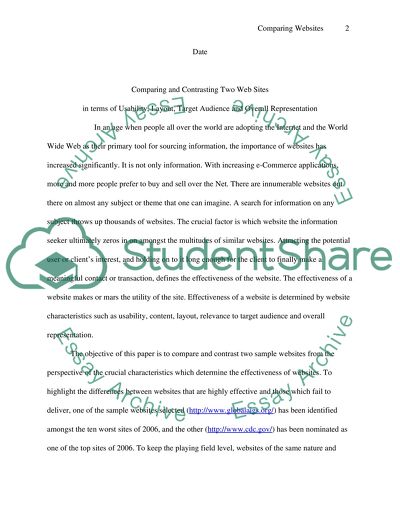Cite this document
(Comparing and Contrasting Web Sites in terms of Usability, Layout, Essay Example | Topics and Well Written Essays - 2500 words, n.d.)
Comparing and Contrasting Web Sites in terms of Usability, Layout, Essay Example | Topics and Well Written Essays - 2500 words. https://studentshare.org/information-technology/1540870-compare-and-contrast-two-websites-exploring-and-analysing-issues-of-usability-purpose-of-layout-target-audience-website-identity-and-overall-representatio
Comparing and Contrasting Web Sites in terms of Usability, Layout, Essay Example | Topics and Well Written Essays - 2500 words. https://studentshare.org/information-technology/1540870-compare-and-contrast-two-websites-exploring-and-analysing-issues-of-usability-purpose-of-layout-target-audience-website-identity-and-overall-representatio
(Comparing and Contrasting Web Sites in Terms of Usability, Layout, Essay Example | Topics and Well Written Essays - 2500 Words)
Comparing and Contrasting Web Sites in Terms of Usability, Layout, Essay Example | Topics and Well Written Essays - 2500 Words. https://studentshare.org/information-technology/1540870-compare-and-contrast-two-websites-exploring-and-analysing-issues-of-usability-purpose-of-layout-target-audience-website-identity-and-overall-representatio.
Comparing and Contrasting Web Sites in Terms of Usability, Layout, Essay Example | Topics and Well Written Essays - 2500 Words. https://studentshare.org/information-technology/1540870-compare-and-contrast-two-websites-exploring-and-analysing-issues-of-usability-purpose-of-layout-target-audience-website-identity-and-overall-representatio.
“Comparing and Contrasting Web Sites in Terms of Usability, Layout, Essay Example | Topics and Well Written Essays - 2500 Words”. https://studentshare.org/information-technology/1540870-compare-and-contrast-two-websites-exploring-and-analysing-issues-of-usability-purpose-of-layout-target-audience-website-identity-and-overall-representatio.


